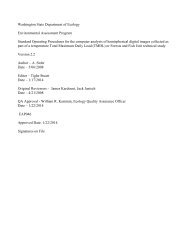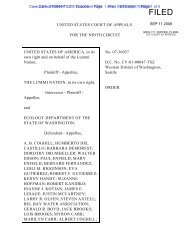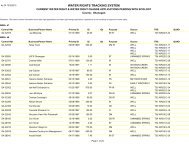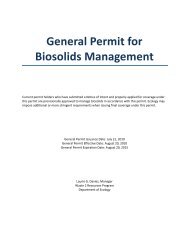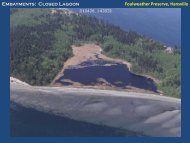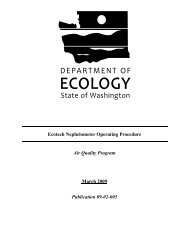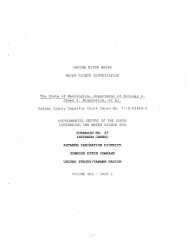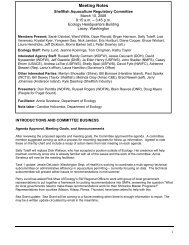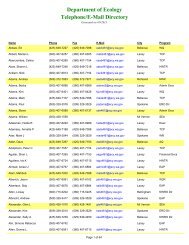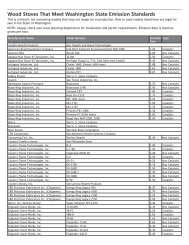WRIA 62 WMP 032305 - Washington State Department of Ecology
WRIA 62 WMP 032305 - Washington State Department of Ecology
WRIA 62 WMP 032305 - Washington State Department of Ecology
Create successful ePaper yourself
Turn your PDF publications into a flip-book with our unique Google optimized e-Paper software.
March, 2005 -84- 023-1289-003.3040<br />
5.1.7 Joint Stock Assessment Project<br />
The Kalispel Natural Resources <strong>Department</strong> (KNRD) leads the Joint Stock Assessment Project<br />
(JSAP) which, in part, collects and maintains fish distribution and habitat data for the area in<br />
<strong>Washington</strong> that is above Chief Joseph dam and blocked to anadromous fish passage. The JSAP is a<br />
cooperative project, funded by BPA and lead by KNRD, with the Spokane Tribe, Colville Tribe, and<br />
<strong>Washington</strong> <strong>Department</strong> <strong>of</strong> Fish and Wildlife as cooperators. Current data contributors, other than<br />
the coordinating entities, include the Colville National Forest, Eastern <strong>Washington</strong> University, and<br />
the <strong>Department</strong> <strong>of</strong> <strong>Ecology</strong>. Fisheries and habitat data has been compiled into a 195 megabyte<br />
database written using Micros<strong>of</strong>t SQL Server 2000. The Kalispel Tribe is currently working with a<br />
consultant to build a web-enabled geographical user interface using ArcIMS. The database is hosted<br />
by the Kalispel Tribe in Spokane on a server with over 240 gigabytes <strong>of</strong> space. There is space<br />
available to host additional data.<br />
5.1.8 Tri-<strong>State</strong> Water Quality Council<br />
The Tri-<strong>State</strong> Water Quality Council is a non-pr<strong>of</strong>it group that works to improve water quality<br />
throughout the Clark Fork River and Pend Oreille River in Montana, Idaho and <strong>Washington</strong>. The<br />
Council works to carry out the water quality protection measures outlined in the Clark Fork - Pend<br />
Oreille Basin Water Quality Study (EPA, 1993). Primary planning objectives <strong>of</strong> this study are to:<br />
• Control nuisance algae growth in the Clark Fork River by reducing nutrient<br />
concentrations from point and non-point sources <strong>of</strong> pollution;<br />
• Protect Pend Oreille Lake water quality by maintaining or reducing current rates <strong>of</strong><br />
nutrient loading from the Clark Fork River;<br />
• Reduce near shore eutrophication in Pend Oreille Lake by reducing nutrient loading from<br />
local non-point sources; and,<br />
• Improve Pend Oreille River water quality through aquatic weed management and nonpoint<br />
source controls in tributaries.<br />
To carry out these objectives, the Council has developed a basin-wide water quality monitoring<br />
program, public education programs, and numerous ad hoc committees focused on point and nonpoint<br />
pollution sources.<br />
The Council’s goals for 2000-2005 are:<br />
1. Develop a stable funding base - including congressional, agency and philanthropic<br />
support;<br />
2. Involve non-point source groups in the development and implementation <strong>of</strong> in-stream<br />
targets and programs;<br />
3. Continue to integrate good science (data collection, analysis, interpretation and<br />
sharing) in all Council activities including the basin-wide monitoring program;<br />
4. Continue to implement and modify the VNRP to meet 10-year targets;<br />
5. Develop a Pend Oreille Lake management strategy;<br />
6. Ensure quality staff to adequately administer programs and manage the organization;<br />
7. Continue to ensure the health and development <strong>of</strong> the Council through:<br />
<strong>WRIA</strong> <strong>62</strong> <strong>WMP</strong> <strong>032305</strong>



